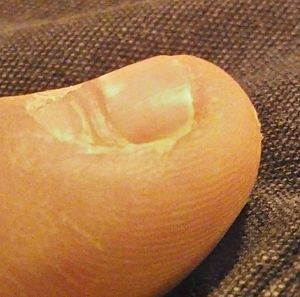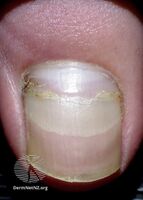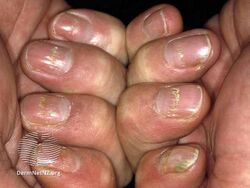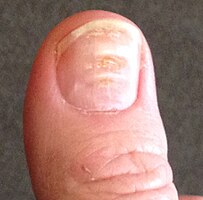Beau lines
| Beau lines | |
|---|---|
| Other names: Beau's lines, transverse nail ridgings, Beau-Reil groove[1] | |
 | |
| Beau's lines on the middle fingernail of the left hand caused by a paronychia infection | |
| Symptoms | Grooves that run across the nails[2] |
| Causes | Severe illness, chemotherapy, Raynaud disease, pemphigus[3] |
| Differential diagnosis | Mee's lines, leukonychia, Muehrcke's nails[4] |
| Treatment | Directed at the underlying cause[3] |
| Frequency | Relatively common[5] |
Beau lines are groves of varying depths that run across the nail plate.[2] Generally all nails are involved at the same level; though trauma may result in a single nail being affected.[6]
Causes include severe illness, chemotherapy, Raynaud disease, trauma, malnutrition, and pemphigus.[3][7] In some cases the cause remains unknown.[7] It may be seen with eczema or psoriasis.[8] The underlying mechanism involves disruption in nail growth.[3] As nails grow approximately 1 mm every 8 days, the distance the lines have moved indicate when the causative event occurred.[9] If multiple lines are present within the same nail it indicates multiple causal events.[10]
Treatment is directed at the underlying cause.[3] The lines will grow out and resolve without any specific measures.[11] They are relatively common.[5] They are named after the French physician, Joseph Honoré Simon Beau, who first described them in 1846.[1][9]
Signs and symptoms
Beau's lines are horizontal, going across the nail, and should not be confused with vertical ridges going from the bottom (cuticle) of the nail out to the fingertip. These vertical lines are usually a natural consequence of aging and are harmless.[12][13]
Beau's lines should also be distinguished from Muehrcke's lines of the fingernails. While Beau's lines are actual ridges and indentations in the nail plate, Muehrcke lines are areas of hypopigmentation without palpable ridges; they affect the underlying nail bed, and not the nail itself. Beau's lines should also be distinguished from Mees' lines of the fingernails, which are areas of discoloration in the nail plate.
-
Beau lines
-
Beau lines
-
Beau lines
Causes
There are several causes of Beau's lines. It is believed that there is a temporary cessation of cell division in the nail matrix. This may be caused by an infection or problem in the nail fold, where the nail begins to form, or it may be caused by an injury to that area. Some other reasons for these lines include trauma, coronary occlusion, hypocalcaemia, and skin disease. They may be a sign of systemic disease, or may also be caused by an illness of the body, as well as drugs used in chemotherapy, or malnutrition.[14][15] Beau's lines can also be seen one to two months after the onset of fever in children with Kawasaki disease.[16]
A researcher found Beau's lines in the fingernails of two of six divers following a deep saturation dive to a pressure equal to 305 metres (1,001 ft) of sea water, and in six of six divers following a similar dive to 335 metres (1,099 ft).[17] They have also been seen in Ötzi the Iceman.
Human nails grow at a rate which varies with many factors: age, and the finger or toe in question as well as nutrition. However, typically in healthy populations fingernails grow at about 0.1mm/day and toenails at about 0.05mm/day.[18] With this in mind the date of the stress causing Beau's lines and other identifiable marks on nails can be estimated.
See also
References
- ↑ 1.0 1.1 Singal, Archana; Neema, Shekhar; Kumar, Piyush (2019). Nail Disorders: A Comprehensive Approach. CRC Press. p. 30. ISBN 978-1-351-13970-0. Archived from the original on 2021-08-28. Retrieved 2020-11-27.
- ↑ 2.0 2.1 Bellet, Jane Sanders (2021). "Paediatric nail disorders". In Lipner, Shari (ed.). Nail Disorders: Diagnosis and Management, An Issue of Dermatologic Clinics. Philadelphia: Elsevier. p. 232. ISBN 978-0-323-70923-1. Archived from the original on 2022-05-08. Retrieved 2023-08-09.
- ↑ 3.0 3.1 3.2 3.3 3.4 Tully, AS; Trayes, KP; Studdiford, JS (15 April 2012). "Evaluation of nail abnormalities". American family physician. 85 (8): 779–87. PMID 22534387.
- ↑ Studdiford, James S.; Altshuler, Marc; Salzman, Brooke; Tully, Amber S. (2009). Images from the Wards: Diagnosis and Treatment E-Book. Elsevier Health Sciences. p. 110. ISBN 978-1-4557-2680-6. Archived from the original on 2021-08-29. Retrieved 2020-11-27.
- ↑ 5.0 5.1 ANP-BC, Karen M. Myrick, DNP, APRN, FNP-BC; ANP-BC, Laima Karosas, PhD, APRN, FNP-BC (2019). Advanced Health Assessment and Differential Diagnosis: Essentials for Clinical Practice. Springer Publishing Company. p. 132. ISBN 978-0-8261-6255-7. Archived from the original on 2021-08-28. Retrieved 2020-11-27.
- ↑ Tosti, Antonella (2020). "413. Diseases of hair and nails". In Goldman, Lee; Schafer, Andrew I. (eds.). Goldman-Cecil Medicine. Vol. 2 (26th ed.). Philadelphia: Elsevier. pp. 2660–2661. ISBN 978-0-323-53266-2. Archived from the original on 2023-06-30. Retrieved 2023-05-31.
- ↑ 7.0 7.1 Ferri, Fred F. (2010). Ferri's Differential Diagnosis E-Book: A Practical Guide to the Differential Diagnosis of Symptoms, Signs, and Clinical Disorders. Elsevier Health Sciences. p. 339. ISBN 978-0-323-08163-4. Archived from the original on 2021-08-29. Retrieved 2020-11-27.
- ↑ Berker, David de (2019). "20. Diseases of the nails". In Morris-Jones, Rachael (ed.). ABC of Dermatology (7th ed.). Hoboken: Wiley Blackwell. p. 167. ISBN 978-1-119-48899-6. Archived from the original on 2023-08-05. Retrieved 2023-08-13.
- ↑ 9.0 9.1 Fawcett, RS; Linford, S; Stulberg, DL (15 March 2004). "Nail abnormalities: clues to systemic disease". American family physician. 69 (6): 1417–24. PMID 15053406.
- ↑ Bolognia, Jean L.; Jorizzo, Joseph L.; Rapini, Ronald P. (2003). Dermatology. Elsevier. p. 1091. ISBN 978-99976-38-99-1. Archived from the original on 2021-08-28. Retrieved 2020-11-27.
- ↑ Saavedra, Arturo; Roh, Ellen K.; Mikailov, Anar (2023). "32.Disorders of the nail apparatus". Fitzpatrick's Color Atlas and Synopsis of Clinical Dermatology (9th ed.). New York: McGraw Hill Professional. pp. 849–872. ISBN 978-1-264-27801-5. Archived from the original on 2023-12-31. Retrieved 2024-01-18.
- ↑ Google Answers: Vertical Ridges Archived 2009-02-25 at the Wayback Machine, citing several different studies and experts. Accessed April 7, 2009.
- ↑ Mayo Clinic: Vertical Ridges Archived 2009-02-07 at the Wayback Machine. Accessed April 7, 2009.
- ↑ Ben-Dayan D, Mittelman M, Floru S, Djaldetti M (1994). "Transverse nail ridgings (Beau's lines) induced by chemotherapy". Acta Haematol. 91 (2): 89–90. doi:10.1159/000204261. PMID 7517608.
- ↑ Park J; Li K (2010). "Multiple Beau's lines". New England Journal of Medicine. 362 (20): e63. doi:10.1056/NEJMicm0906698. PMID 20484394.
- ↑ Fimbres AM, Shulman ST. "Kawasaki Disease". Pediatr rev 2008; 29; 308–316.
- ↑ Schwartz H (2006). "Clinical observation: Beau's lines on fingernails after deep saturation dives". Undersea Hyperb Med. 33 (1): 5–10. PMID 16602251. Archived from the original on 2012-06-03. Retrieved 2009-02-16.
- ↑ Yaemsiri S, Hou N, Slining M, He K (2009). "Growth rate of human fingernails and toenails in healthy American young adults". Journal of the European Academy of Dermatology and Venereology. 24 (4): 420–423. doi:10.1111/j.1468-3083.2009.03426.x. PMID 19744178. S2CID 856692.
External links
| Classification |
|---|


